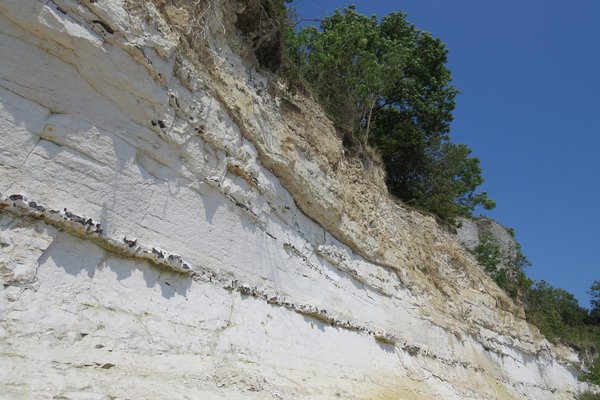Denmark
Stevns Klint
Stevns Klint illustrates the impact of an asteroid that created the global mass extinction of species some 67 million years ago, known as the Chicxulub event.
These cliffs show high-quality exposure of the Cretaceous-Tertiary (K/T) boundary section: the border is visible as a reddish layer in the strata. Scientists here developed a new theory that the mass extinction that ended the Age of Dinosaurs wasn’t caused by extensive volcanism in India, but was due to the impact of a giant asteroid. The cliffs of Stevns Klint are also rich in fossils from before and after the K/T boundary layer.
Community Perspective: Only die-hard WHS collectors come here for anything else than the coastal panoramas and ice cream: it is to look at that one narrow sediment layer. The Kalklandet app is needed to help ‘see’ it. Ian and Clyde managed to find some fossils too. Claire reports that the small onsite museum has now been closed (2019) and it seems that “whoever is in charge of managing this site has lost interest in it”.
Site Info
Official Information
- Full Name
- Stevns Klint (ID: 1416)
- Country
- Denmark
- Status
-
Inscribed 2014
Site history
History of Stevns Klint
- 2014: Inscribed
- Inscribed
- 2013: Incomplete - not examined
- Type
- Natural
- Criteria
- viii
Links
- UNESCO
- whc.unesco.org
- Official
-
- kalklandet.dk — Welcome to Kalklandet
All Links
UNESCO.org
- whc.unesco.org — whc.unesco.org/
Official Website
- kalklandet.dk — Welcome to Kalklandet
News Article
- Jan. 28, 2025 bbc.com — 66 million-year-old fish vomit discovered in Denmark
- July 20, 2014 shanghaidaily.com — Tourists swarm in to Stevns Klint
Community Information
- Community Category
- Paleontology: Non-hominid fossils
Travel Information
Free entrance
Copenhagen Hotspot
Recent Connections
-
Chalk
"Stevns Klint, known as the Cliffs of S…
-
Untranslated Toponyms
Klint = "a geological term of Scandinav…
-
Inscribed on a single criterion only
Crit viii
Connections of Stevns Klint
- Geography
-
-
Baltic Sea
-
Linear inscriptions
Follows the narrow coast line for 15km
-
- Trivia
-
-
In private ownership
The cliff is primarily private property with the local estate Gjorslev Gods as the largest owner (95 % of the cliff is owned by this private landowner). (AB ev) -
Smallest natural WHS
50 ha (3)
-
- History
-
-
Cold War
Koldkrigsmuseum Stevnsfort / Tunnels in Cold War Fortress StevnsfortSee whc.unesco.org
-
- Ecology
- Damaged
-
-
Meteorite impact
a globally exceptional representation of the evidence of the Chixulub meteorite impact that took place at the end of the Cretaceous Period, c.67 million years ago (OUV)
-
- World Heritage Process
-
-
Inscribed on a single criterion only
Crit viii
-
- Constructions
-
-
Lighthouses
Two protected lighthouses
-
- WHS on Other Lists
- Timeline
-
-
Paleocene
records the exact boundary between 2 periods (Cretacious-Paleocene)
-
- WHS Hotspots
-
-
Copenhagen Hotspot
About an hour's drive or 2 hours by public transport
-
- Science and Technology
-
-
Scientific Developments
It was one of the three sites studied by Álvarez before publising his famous hypothesis about the K-T extinction eventSee en.wikipedia.org
-
- Visiting conditions
-
-
Free entrance
There's no entrance fee to the cliffs
-
- WHS Names
-
-
Untranslated Toponyms
Klint = "a geological term of Scandinavian origin describing a coastal cliff or escarpment; the term has its roots in the Old Norse word "klint," meaning cliff."
-
News
- bbc.com 01/28/2025
- 66 million-year-old fish vomit dis…
- shanghaidaily.com 07/20/2014
- Tourists swarm in to Stevns Klint
Recent Visitors
Visitors of Stevns Klint
- Adrian Turtschi
- Afshin Iranpour
- Albert
- Alberto Rodriguez Gutierrez
- Alexander Barabanov
- Alexander Lehmann
- Ana Lozano
- anthonybonbon
- Argo
- Ask Gudmundsen
- Astraftis
- Atila Ege
- Axel Hansson
- Bill Maurmann
- Bin
- Birgitte Sørensen
- Bodil Ankerly
- Bram de Bruin
- c82wc1
- Caspar
- Cezar Grozavu
- Christoph
- Christravelblog
- Claire Bradshaw
- ClaraHH
- Clyde
- Cobaltrage
- Colossus
- Csaba Nováczky
- ctravel
- Dagmara
- Daniel Chazad
- Dan Pettigrew
- David Berlanda
- Dimitar Krastev
- Dimitrios Polychronopoulos
- Dirk-pieter
- Dorejd
- Echwel
- Elaine McArdle
- Ellen Nielsen
- Els Slots
- Erfe91
- Erik Jelinek
- Eva Kisgyorgy
- Evgenii
- Farinelli
- Feldhase
- Femke Roos
- Filippo Ubaldi
- Flexiear
- Frederik Dawson
- FS
- George Gdanski
- GeorgeIng61
- Grzegorz Andruszkiewicz
- Hadrianus
- Harry Mitsidis
- hegeline@icloud.com
- henrik_hannfors
- Hubert
- Iain Jackson
- Ian Cade
- Ingemar Eriksson
- Ivan Rucek
- Jakob F.
- Janina Lehmann
- Janos
- Jarek Pokrzywnicki
- Jay T
- Jean Lecaillon
- Jesse S 2010
- Jezza
- JobStopar
- Joel on the Road
- John Smaranda
- Jonas Hagung
- Jonas Kremer
- Jonas Martinsson
- JoStof
- Juha Sjoeblom
- KarenBMoore
- Karito Vies
- Kasia M.
- Kasper
- Kbecq
- Knut
- Kurt Lauer
- Lara Adler
- Liamps91
- Lisu Marian
- Lithobates
- Luboang
- Luis Filipe Gaspar
- Lukasz Palczewski
- Maciej Gil
- marcel staron
- Martina Rúčková
- Matthewsharris
- MaYumin
- Mikko
- Mohboh
- Monica66
- MoPython
- Mtlmr
- nan
- Nasebaer
- natlefebvre@hotmail.
- Nihal Ege
- nikolasruffet
- Patrik
- peacemaker2142
- Peter Lööv
- Philipp Leu
- Philipp Peterer
- Piotr Wasil
- Rachel Perkins
- Ralf Regele
- Randi Thomsen
- Rodinia
- Roger Ourset
- Roman Bruehwiler
- Roman Raab
- Rudegirl
- Sabrina Liebehentschel
- Schnitzel
- serghei.belous
- Sergio Arjona
- Shandos Cleaver
- Simonh
- SirLoydd
- Slavi
- sncjob
- Stanislaw Warwas
- Stefan Loov
- Svein Elias
- Szabolcs Mosonyi
- Szucs Tamas
- Tamara Ratz
- Taotao Chen
- Tarquinio_Superbo
- Tevity
- Thomas Buechler
- Thomas van der Walt
- Thorben
- Tinuszke
- Tom Flaten
- triath
- Tsunami
- usagi1974
- Van Hung
- voyager
- Walter
- Westwards
- Wojciech Fedoruk
- YaroMir
- Zoë Sheng
Community Reviews
Show full reviews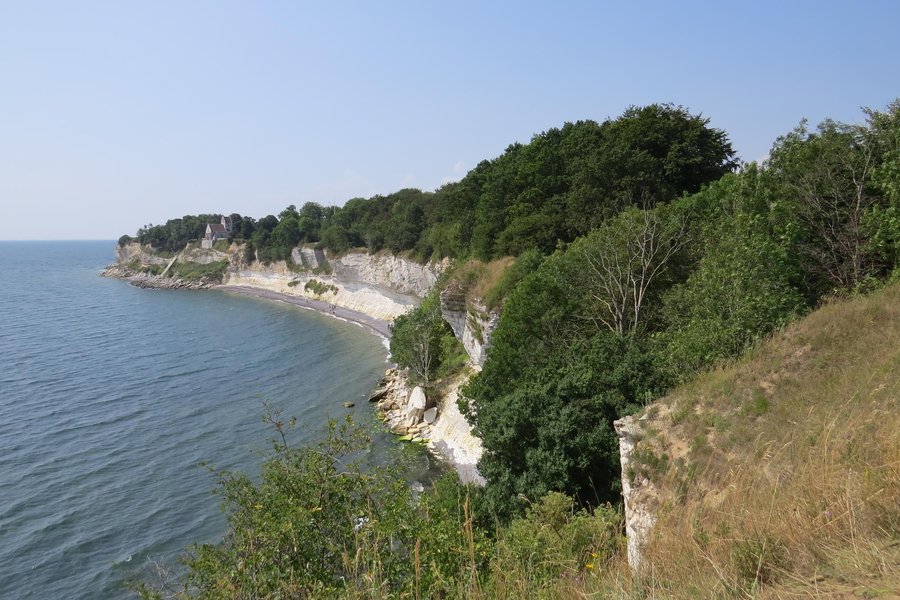
I really enjoyed my visit to Stevns Klint today, on what was one of the only dry days we have had during our visit to Denmark. However......it seems a bit like whoever is in charge of managing this site has lost interest in it. The car-park and restaurant are well maintained, presumably because they make an income, but the rest of the site seems lost.
Clearly though Denmark is enthusiastic about the site as it is signed extremely well from every possible approach, and from many miles away. But then on arrival there is very little mention of the UNESCO listing, nor information relating to the actual reason for the listing in the first place.
In earlier reviews, there is mention of the small museum. This has now been closed, permanently it seems. Instead, there is a small caravan, yes really, which has a small amount of detail relating to the geological layers found at the site. Sadly this is very brief, does not highlight the location of the all important fish clay layer, and is all in Danish. The App which is mentioned by a few reviewers has now been dis-continued pending the release of a better one, but no time-frame for this is given. Also, on the website there is a suggestion that a new Visitor Centre is being built, but I have visited a number of locations along the coast today and saw no evidence of this.
So I was pleased that I had …
Keep reading 0 comments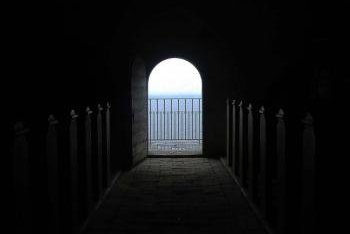
The night before I explored Stevns Klint I arrived in Hojerup after taking 4 trains and 5 buses from Schleswig TWHS in Germany, stopping in Christiansfeld WHS on the way, all connections of which were researched well in advance.
But when I arrived at my B&B about 7 pm, exhausted, I was shocked to hear from the owner that there was absolutely no restaurant or even store in Hojerup that were open at that time. The nearest would be 4 km away. Having no car, I did not have an option to get to the nearest town, as there were also no buses after 7 pm. So, I asked the owner if I could have a half of the breakfast for dinner and the other half for breakfast, which he duly complied. The inclusion of a whole loaf of bread in the breakfast helped. Or maybe he did me a favor.
It was raining in the next morning when I explored Stevns Klint. I went down to the beach area to take a closer look at the “fish clay.”
Stevns Klint has to do with the impact of a giant asteroid from 65 million years ago. But most of the things about Stevns Klint have been already said in the previous reviews. I would only add that this is the first WHS that made me think it should perhaps be called a Universal Heritage Site, as it involved a meteor, atmospheres, dinos, and whatnot.
My favorite …
Keep reading 0 comments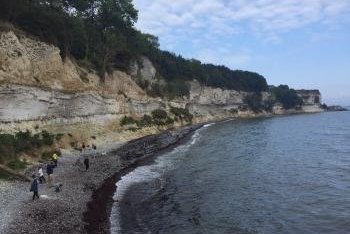
Visited Stevns Klint in September 2017. The place is very popular among locals, who seemingly spent the whole day there walking along the coastline and some attraction points like COld War Museum.
Also spent around 30 minutes trying to find any fossil on the beach below Stevns Klint but without success.
Information leaflets provide indication of where very thin K/T layer is located.
For ordinary person it's difficult to fully understand the scientific importance of this layer, but this is an integral part of WH sites, which cover so many different aspects of history, nature and culture, that they can't all be stunning lookers. You'd never know more details and information about extinction event and mysterious disappearance of the dinosaurs from the Earth. In overall, the place is quite a fun to explore and the sea views are good.
As suggested by Clyde, next time will go to quarry Holtug Kridtbrud in order to find fossil.
Keep reading 0 comments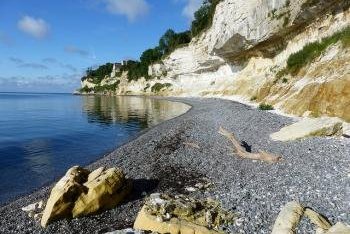
I visited this WHS in July 2016. I'd recommend downloading the huge informative Kalklandet app on your smart phone before visiting this site. It will help you locate the thin fish clay layer as well as identify any fossils you might find. The museum opens at 10am and apart from a few fossil examples and information boards, it is more of a local museum. The parking lot is automated so you'll still have to pay the day ticket to get out once your visit is ready. You can also pay by card so no cash or coins are needed. Knowing that bad weather was forecast in the afternoon, I decided to visit very early in the morning around 6:30-7am. This choice made all the difference as I had the whole site for myself for 3-4 hours. Firstly, I went down to the pebble beach by descending a relatively new but very steep steel staircase. Then you ascend a smaller but very old wooden staircase (which has seen better days!) and a very short trail through a patch of overgrowth full of peacock butterflies brought me to an apparent dead end and excellent lookout point (most of the pictures of previous reviews are from this viewpoint). I carefully climbed down to the beach over some loose rocks and limestone and was overjoyed to have the beach for myself. The morning sunlight is the best for photography and also very helpful to be able to spot the fish clay layer which is …
Keep reading 0 comments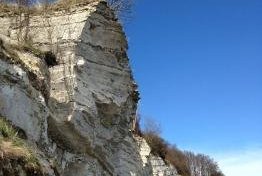
“Well the cliff isn’t going to stare at itself!”
It seems that statement didn’t fully convince my colleagues that my weekend trip to Denmark was a worthwhile undertaking. But I must admit, this turned out to be the most interesting site, from the underwhelming batch of recent additions the Danish have flung onto the world heritage list.
On my drive to the site I listened to an episode of the BBC’s impressive (though unabashedly highbrow) In Our Time about the KT boundary. It did a great job of explaining the importance of the scientific discovery and also goes to show the sort of hedonistic experience you get on a holiday with me, ¡¡Cruising in a Dacia Sandero, pumping out the Melvyn Bragg, bring your neon vest and glow sticks!!
Els has already described the visiting experience well, so no real need to expand on that. Just to say that in 2016 the museum still feels a little temporary, but explained everything I needed to know in a small manageable chunk, it also provided free wifi to enable me to download the very useful free app, that explained facts in further detail and pointed out features when I was at the cliff itself.
The unseasonably heavy snow (it was late April) had abated by the time I descended down to the beach and the blue sky and crystal clear water gave an almost tropical feel, undermined only by the near zero temperatures.
I spent a fair while just …
Keep reading 0 comments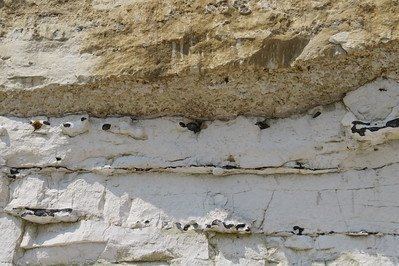
We already had these Pile Dwellings, where you have to stare intently into a lake to try and see some rotten wooden poles. And since this year we, WHS collectors, have had to look at a 5 to 10-cm thick sediment layer in a cliff wall. Try explaining this to your colleagues at work.
Despite all of this, Stevns Klint certainly isn't an obscure site. It is signposted from the motorway from afar. The road ends at a car park, and although the site has no entrance fee there's no escape from paying for the parking. When I arrived at about 11 a.m. (having flown in from Amsterdam to Copenhagen earlier in the morning), there were already about 40 other cars present.
I started with a visit to the 'museum', which seemed somewhat makeshift. The story of the site is told via information panels. In the corners of the exhibition hall, some of the old exhibits (regional historic and folkloric stuff) still can be seen. As the visitor numbers have increased significantly since Stevns Klint became a WHS, they're planning to build a new visitor center.
On the other side of the parking lot lies the infamous Old Church, which lost a part of its architecture in 1928 when the underlying cliff collapsed. The church was constructed of local limestone, and you can still see the marks on the cliffs where the stones for this and other buildings in the area have been carved out.
From …
Keep reading 0 comments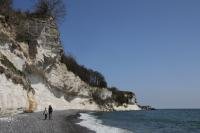
Stevns Klint lies about 45 minutes drive from Copenhaguen. It is a 15 km long cliff along the coastline in which it is very easy to see different layers of strates. The upper strate is a Creataceous chalk (rich in fossiles) and the lower strate is a Tertiary Period limestone.
The boundary between the Crataceous and Tertiary layer is a layer of fish clay, containing traces of great mass death (massive extinction of animals thought to be due to Earth being hit by a massive asteroïd).
Visit to Stevn Klint is like reading in the Earth History Book. And those layer can be seen by inexpecienced persons.
I drove to the village of Hojerup. The old church of that village is right on the cliff edge. Part of the churhc even collapsed into the sea in 1928. A strairway leads to the beach, where you can actually touch the different layers (and maybe find fossiles - even if I did not). Back up again, a pathway follows the cliff edge (you can actually hike along the 15 km of the cliffs). There is a small museum there.
A few minutes north is the Setns Fyr (a lighthouse) from where you can see the Oresund bridge to the north and the Mon Island in the south.
Altogether, the Stevns Klint is a nice half day trip from Copenhague, altough only with good weather confitions.
Keep reading 0 comments
